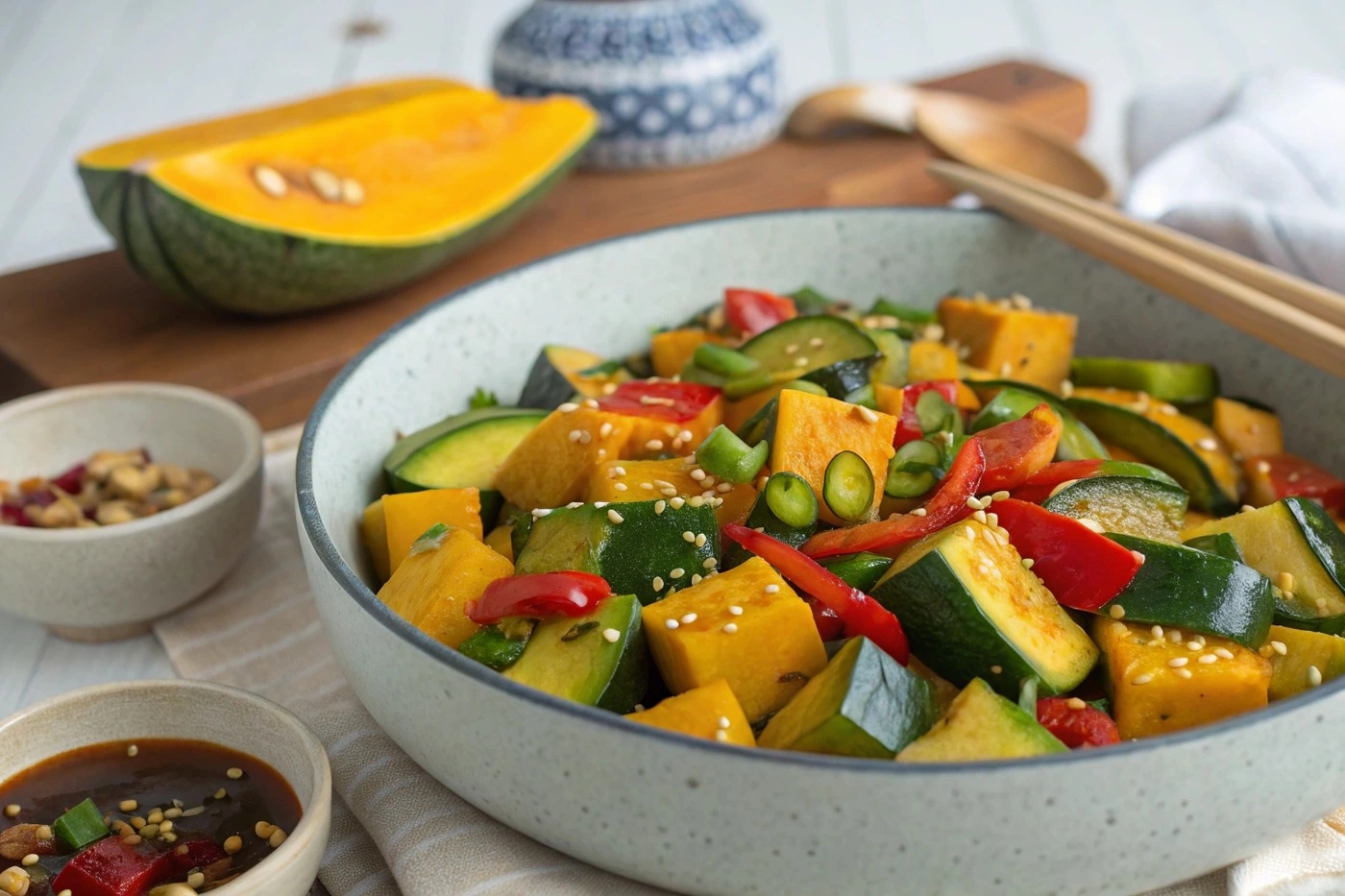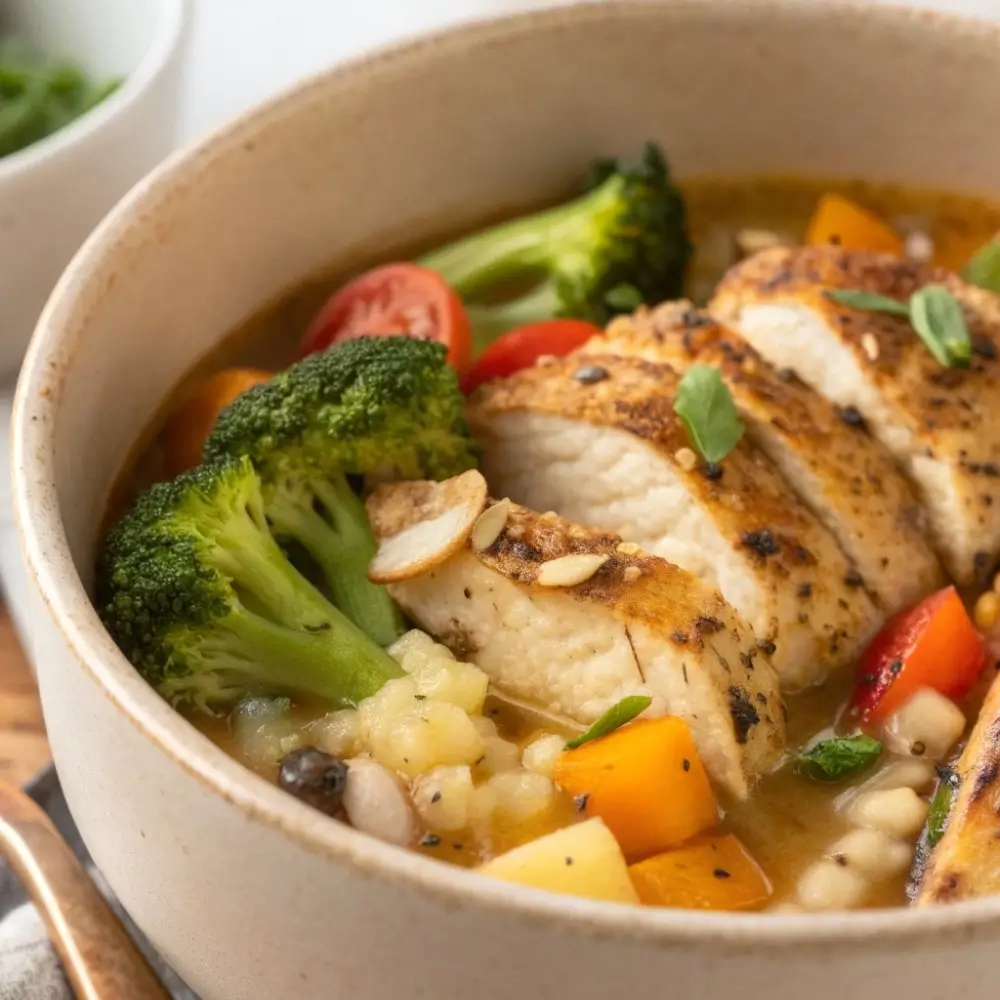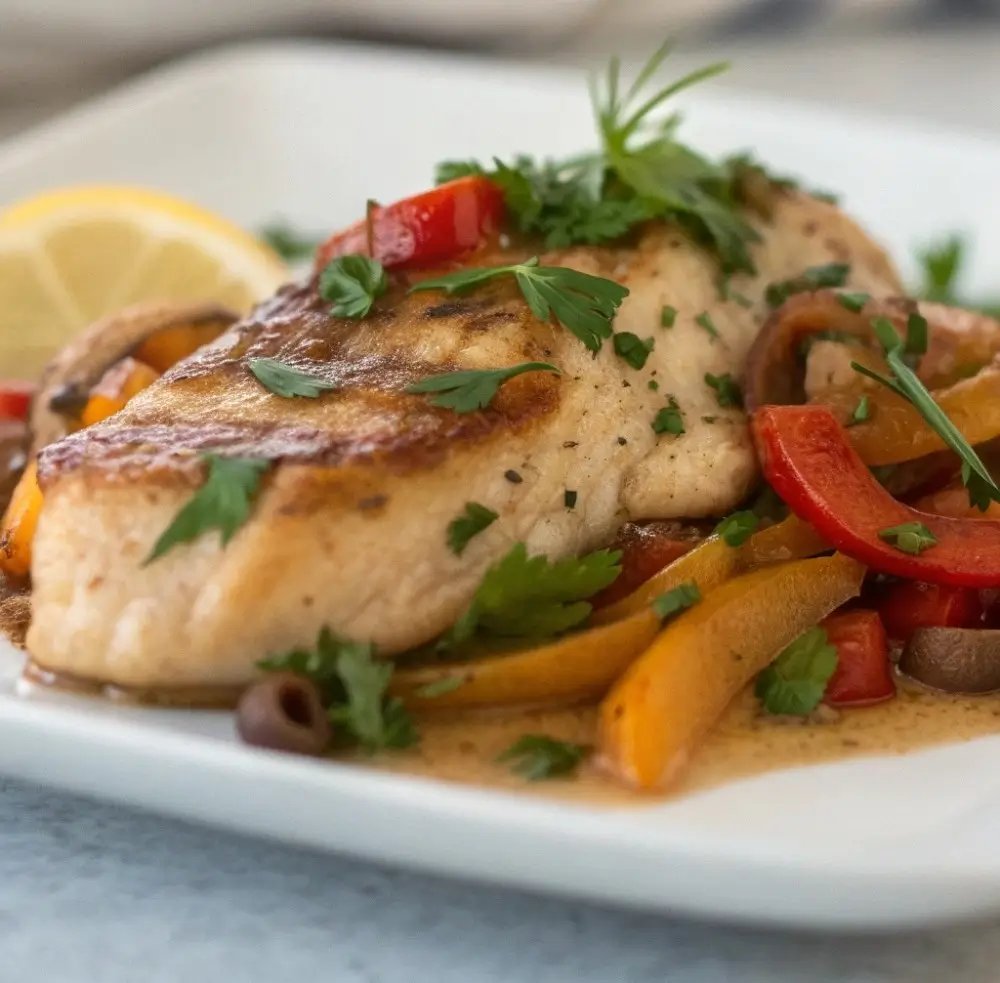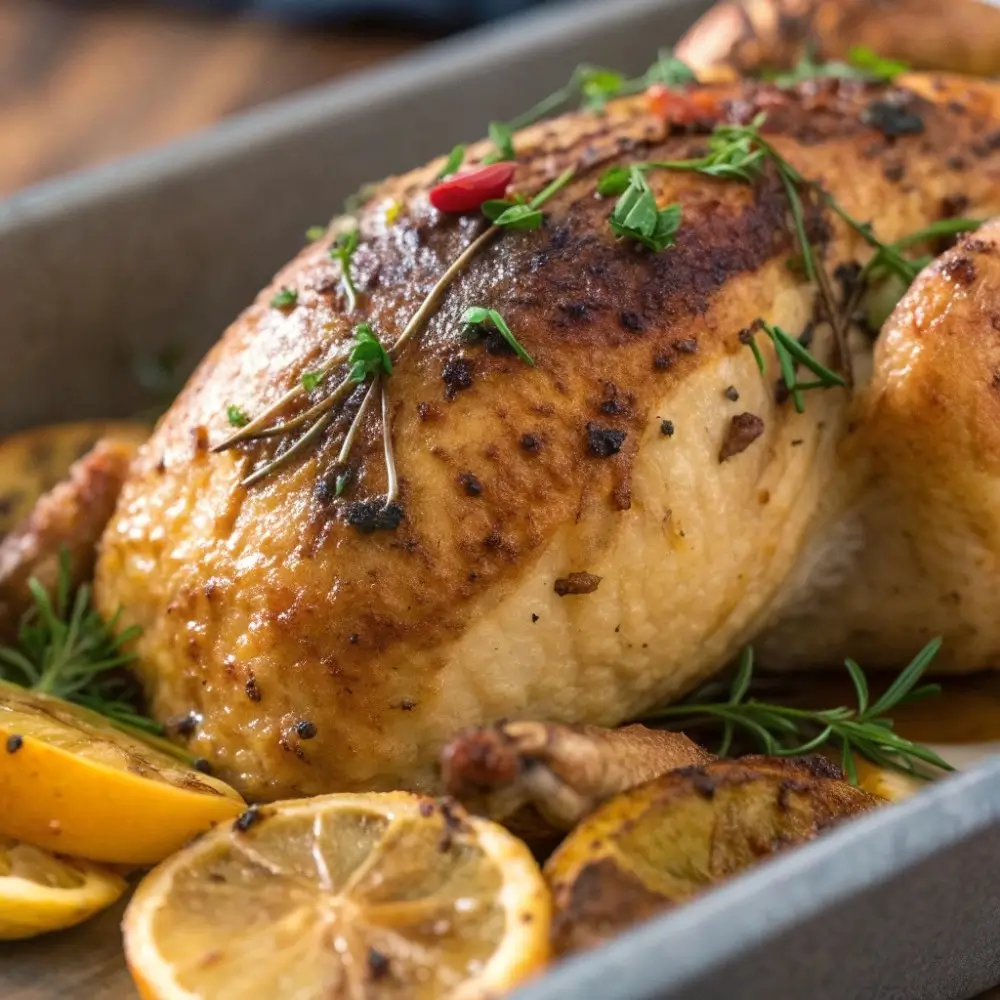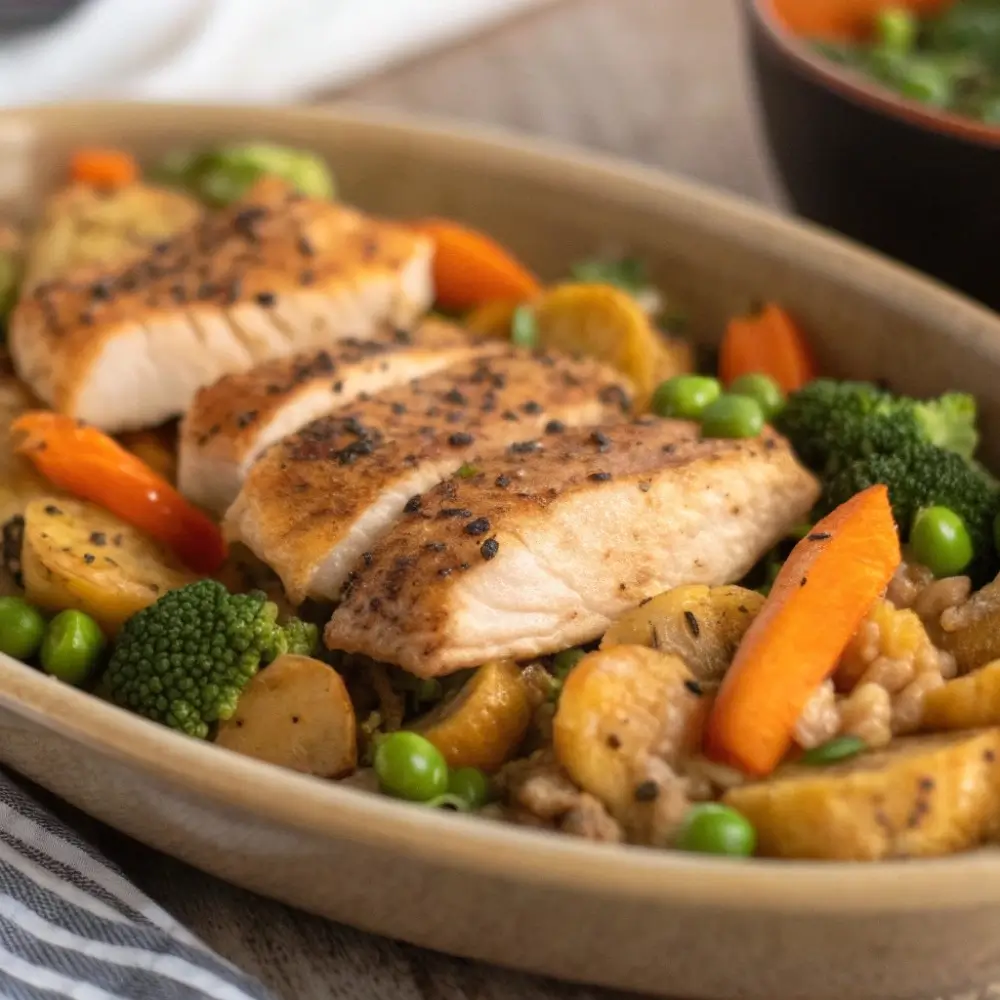Table of Contents
- 1 Introduction to Chinese Squash Recipes Kabocha Vegan
- 2 Ingredients for Vegan Chinese Squash Recipes Using Kabocha
- 3 Optional Ingredients for Extra Flavor
- 4 How to Cook Kabocha Squash for Vegan Chinese Dishes
- 5 Tips for Perfectly Cooking Kabocha Squash
- 6 Top 5 Chinese Squash Recipes Kabocha Vegan
- 7 Health Benefits of Kabocha Squash in Vegan Dishes
- 8 How Kabocha Squash Supports a Vegan Diet
- 9 How to Serve Chinese Squash Recipes Kabocha Vegan
- 10 Vegan Chinese Kabocha Squash Variations and Substitutes
- 11 FAQs on Chinese Squash Recipes Kabocha Vegan
- 12 Conclusion: Why Kabocha Squash is Perfect for Vegan Chinese Recipes
Introduction to Chinese Squash Recipes Kabocha Vegan
If you’re looking to add a nutritious twist to your vegan Chinese cooking, kabocha squash is your secret weapon. This bright green, round squash is not only incredibly versatile but also brimming with health benefits. In Chinese cuisine, it’s often used in stir-fries, soups, and stews, where its sweet, creamy texture enhances the dish. Whether you’re a long-time fan of kabocha or just discovering it, this article will take you on a culinary journey, showcasing a variety of vegan Chinese squash recipes that bring out the best of this humble vegetable. From stir-fries to soups, kabocha squash makes a perfect base for flavorful plant-based meals that are both comforting and nourishing.
But what exactly is kabocha squash, and why is it so popular in vegan Chinese dishes? Read on to find out why this squash should be a staple in your kitchen and how it can elevate your cooking.
What is Kabocha Squash?
Kabocha squash, often referred to as Japanese pumpkin, is a winter squash known for its rich flavor and velvety texture. Unlike many other squashes, kabocha has a slightly sweet taste, with a dense flesh that’s ideal for absorbing bold flavors. This squash is often used in both savory and sweet dishes, thanks to its versatility.
Characteristics and Taste of Kabocha Squash
One of the standout features of kabocha squash is its sweet, earthy flavor. The flesh is thick, smooth, and creamy, making it perfect for soups, stews, and purees. Its dark green skin is edible but typically peeled before cooking, leaving the bright orange interior visible. The flavor is often compared to a blend of sweet potato and pumpkin, with a richer, almost buttery taste. This makes it an excellent choice for vegan recipes, where it complements other plant-based ingredients seamlessly.
Why Kabocha Squash is Ideal for Vegan Chinese Recipes
When it comes to vegan Chinese cooking, kabocha squash checks all the boxes. It not only absorbs the spices and seasonings commonly used in Chinese cuisine, but its hearty texture ensures that it can hold its own in stir-fries, braises, and hot pots. Additionally, it provides the sweetness and depth of flavor that might otherwise be achieved with animal-based ingredients.
Nutritional Benefits of Kabocha Squash
Incorporating kabocha squash into your vegan Chinese dishes is not only a culinary win but also a health boost. Kabocha squash is packed with vitamin A, vitamin C, and fiber, which are essential for maintaining healthy skin, a strong immune system, and digestive health. Plus, it’s low in calories but high in antioxidants, which makes it an excellent addition to any healthy, plant-based diet. It’s one of the best vegetables you can eat, offering a combination of taste and nutritional value that is hard to beat.
Vegan-friendly Nature of Kabocha Squash
As a naturally vegan vegetable, kabocha squash aligns perfectly with plant-based eating. It’s rich in nutrients and can easily be substituted for meat or dairy in many dishes, making it an ideal choice for vegan Chinese recipes. Whether you’re preparing a hearty soup or a savory stir-fry, kabocha’s robust texture and natural sweetness will satisfy both your taste buds and nutritional needs.
Ingredients for Vegan Chinese Squash Recipes Using Kabocha
When it comes to making vegan Chinese dishes with kabocha squash, choosing the right ingredients is essential to achieving the perfect balance of flavor and texture. Here’s a rundown of the key ingredients you’ll need to create these delicious plant-based meals.
Kabocha Squash: Choosing the Right Squash for the Recipe
The star ingredient in these recipes is, of course, kabocha squash. When selecting kabocha, look for a squash with deep green skin and a firm, smooth surface. The size of the squash may vary, so choose one based on the number of servings you need. The flesh should be vibrant orange, and it should feel heavy for its size, indicating it’s full of moisture and flavor. Kabocha is incredibly versatile, so you can roast, steam, or even stir-fry it to your heart’s content, depending on the recipe you’re preparing.
Vegan Substitutes: Tofu, Tempeh, and Other Plant-Based Ingredients
For the protein component in your vegan Chinese dishes, you can’t go wrong with tofu or tempeh. Tofu, with its mild flavor and spongy texture, absorbs the seasonings and spices used in Chinese cuisine beautifully. Tempeh, on the other hand, provides a firmer texture and nutty flavor, making it an excellent option for heartier dishes. These plant-based protein sources work wonderfully in combination with kabocha squash, complementing its rich sweetness and adding substance to the dish.
Aromatics and Seasonings: Garlic, Ginger, Soy Sauce, and Other Staple Flavors in Chinese Cooking
Aromatic ingredients are key in creating the depth of flavor that defines Chinese cuisine. Garlic and ginger are indispensable in vegan Chinese kabocha recipes. They infuse the dish with a fragrant, savory base that pairs perfectly with the natural sweetness of the squash. Soy sauce is a staple seasoning, adding umami and saltiness. You can also experiment with other seasonings like sesame oil, rice vinegar, or even chili paste to add a touch of heat or tanginess.
Optional Ingredients for Extra Flavor
Chinese Five-Spice Powder: The Key to Authentic Chinese Flavor
For a truly authentic Chinese flavor, consider adding Chinese five-spice powder. This aromatic blend typically includes star anise, cloves, Chinese cinnamon, Sichuan peppercorns, and fennel seeds. It brings a unique balance of sweet, savory, and slightly spicy notes that perfectly complement the sweetness of the kabocha squash. A little goes a long way, so use it sparingly to enhance your dish without overpowering the other flavors.
Mushrooms: For Added Texture and Umami Flavor
Mushrooms are a great addition to vegan Chinese kabocha dishes. They provide an extra layer of umami flavor and a meaty texture, making them a perfect pairing with the squash. Shiitake mushrooms, in particular, are commonly used in Chinese cooking for their earthy, rich flavor. You can either stir-fry the mushrooms with the kabocha or add them to a hot pot or soup for an extra savory kick.
How to Cook Kabocha Squash for Vegan Chinese Dishes
Kabocha squash is incredibly versatile, and the way you prepare it can greatly influence the flavor and texture of your dish. Whether you prefer roasting or steaming, both methods bring out the squash’s natural sweetness and create a delicious base for your vegan Chinese recipes. Let’s dive into how to prepare and cook this wonderful vegetable!
How to Prepare Kabocha Squash
Cutting and Peeling Kabocha Squash: Step-by-Step Guide to Preparing Squash
Before you can cook kabocha squash, you’ll need to prepare it properly. The squash’s thick skin can be a bit challenging to cut through, but don’t worry! Here’s a simple, step-by-step guide to cutting and peeling:
- Wash the Squash: Start by washing the exterior of the squash to remove any dirt.
- Cut the Top and Bottom: Use a sharp knife to slice off both ends of the squash. This will create a stable base for cutting.
- Slice in Half: Stand the squash upright and carefully cut it in half. Be sure to use a sturdy knife and apply steady pressure.
- Remove the Seeds: Scoop out the seeds and stringy bits from the center of the squash with a spoon. You can save the seeds for roasting if you like.
- Peel the Skin: While the skin is technically edible, many prefer to peel it for a smoother texture. Use a vegetable peeler or a sharp knife to remove the skin.
Once your squash is prepped, you can move on to cooking it in various ways, depending on the recipe you’re following.
Roasting vs. Steaming: Benefits of Each Cooking Method for Vegan Dishes
Both roasting and steaming are excellent methods for cooking kabocha squash, but each offers unique benefits:
- Roasting: Roasting kabocha squash at a high temperature brings out its natural sugars, creating a delicious caramelized exterior while maintaining a soft, tender interior. This method is perfect for stir-fries or dishes where you want a slightly crispy texture.
- Steaming: Steaming is a gentler cooking method that keeps the squash soft and moist. It preserves the squash’s natural sweetness and is ideal for dishes like soups, hot pots, or when you’re looking for a melt-in-your-mouth texture.
Both methods have their place in vegan Chinese cuisine, so choose based on your desired result for the dish!
Tips for Perfectly Cooking Kabocha Squash
Roasting Kabocha Squash: Achieving a Caramelized Exterior with Tender Inside
To roast kabocha squash, preheat your oven to 400°F (200°C). Cut the squash into wedges or cubes, toss them with a bit of olive oil, and season with salt, pepper, and any spices you like (like Chinese five-spice powder or ginger). Spread the squash in a single layer on a baking sheet and roast for about 25-30 minutes, flipping halfway through. The result? A beautifully caramelized exterior with a tender, soft interior that’s perfect for tossing into stir-fries or serving as a side dish. The roasting process intensifies the natural sweetness of the squash and adds a delightful crispy texture.
Steaming for Softer Dishes: How Steaming Brings Out the Sweetness in the Squash
Steaming is another great option, especially if you want the squash to absorb the flavors of the sauce or broth it’s cooked in. To steam kabocha squash, simply cut it into chunks or wedges and place it in a steaming basket over boiling water. Cover and steam for 15-20 minutes until the squash becomes soft and easily pierced with a fork. The result is a creamy, melt-in-your-mouth texture that pairs beautifully with savory sauces, perfect for soups and hot pots. Steaming preserves the natural sweetness of the squash, allowing it to blend seamlessly into your dish.
Top 5 Chinese Squash Recipes Kabocha Vegan
Now that we’ve explored how to prepare and cook kabocha squash, it’s time to dive into some of the most delicious and easy-to-make vegan Chinese recipes. These dishes highlight the versatility of kabocha squash and show just how well it pairs with plant-based ingredients. Let’s look at five mouthwatering recipes to inspire your next meal!
Recipe 1: Vegan Kabocha Squash Stir-Fry
A simple yet flavorful dish, this vegan kabocha squash stir-fry is perfect for a quick dinner. The squash is stir-fried to crispy perfection, absorbing all the savory seasonings.
Ingredients: What You’ll Need for the Stir-Fry
- 1 medium-sized kabocha squash, peeled and cut into thin slices
- 1 tablespoon sesame oil
- 2 cloves garlic, minced
- 1 tablespoon fresh ginger, minced
- 2 tablespoons soy sauce
- 1 tablespoon rice vinegar
- 1 tablespoon maple syrup (or other sweetener)
- 1/2 teaspoon Chinese five-spice powder
- 1 bell pepper, sliced
- 2 green onions, chopped
- Optional: 1/2 cup mushrooms, sliced
Instructions: Step-by-Step Process
- Heat the sesame oil in a large skillet or wok over medium-high heat.
- Add the garlic and ginger, sautéing until fragrant (about 1 minute).
- Add the kabocha squash slices and stir-fry for about 5-7 minutes, until they begin to soften and brown slightly.
- Add the soy sauce, rice vinegar, and maple syrup, and continue stir-frying for another 5 minutes.
- Toss in the bell pepper and green onions (and mushrooms, if using), cooking for an additional 2-3 minutes.
- Sprinkle with Chinese five-spice powder, toss everything together, and serve hot.
Tips for Best Results: How to Achieve Crispy Squash and Balanced Flavor
For the crispiest squash, make sure the slices are evenly sized and spread them out in the pan to avoid crowding. Stir occasionally, but allow the squash to caramelize slightly on one side before turning it. The balance of sweet and savory flavors is key here, so adjust the soy sauce and maple syrup according to your taste preferences.
Recipe 2: Chinese Braised Kabocha Squash
Ingredients: The Components for Braised Kabocha Squash
- 1 medium kabocha squash, cut into cubes
- 2 tablespoons soy sauce
- 1 tablespoon rice vinegar
- 1 tablespoon hoisin sauce
- 1 teaspoon sesame oil
- 2 cloves garlic, minced
- 1 tablespoon ginger, minced
- 1 cup vegetable broth
- 1 tablespoon brown sugar
- 1 tablespoon cornstarch (optional, for thickening)
- Fresh cilantro for garnish
Instructions: Directions for Slow Braising to Infuse Flavors
- Heat sesame oil in a large pan over medium heat. Add garlic and ginger, cooking until fragrant.
- Add the cubed kabocha squash and sauté for about 5 minutes, allowing the squash to get a light golden color.
- Pour in the soy sauce, rice vinegar, hoisin sauce, and vegetable broth. Stir to combine.
- Bring the mixture to a simmer, then reduce the heat and cover. Let the squash cook for 20-25 minutes, until tender.
- If you prefer a thicker sauce, mix the cornstarch with a little water and stir it into the pan, cooking for another 2-3 minutes until the sauce thickens.
- Serve hot, garnished with fresh cilantro.
Variation: Adding Tempeh for Added Protein
For a protein-packed variation, add cubed tempeh into the braise during the last 10 minutes of cooking. Tempeh will absorb the sauce and add an extra depth of flavor to the dish.
Recipe 3: Vegan Kabocha Squash Soup
This vegan kabocha squash soup is a creamy and comforting dish, perfect for a cozy evening. The soup is velvety smooth and full of flavor, thanks to the sweetness of the squash and the umami of the seasonings.
Ingredients: What You’ll Need to Make the Soup Creamy
- 1 medium kabocha squash, peeled and chopped
- 1 onion, chopped
- 2 cloves garlic, minced
- 2 tablespoons ginger, minced
- 4 cups vegetable broth
- 1/2 cup coconut milk
- 1 tablespoon soy sauce
- 1 teaspoon turmeric
- Salt and pepper to taste
- Optional garnish: Chopped scallions or cilantro
Instructions: How to Blend Flavors for a Rich Vegan Soup
- In a large pot, sauté onion, garlic, and ginger in a little oil until softened, about 5 minutes.
- Add the chopped kabocha squash and vegetable broth. Bring to a boil, then lower the heat and let it simmer for 20-25 minutes, or until the squash is tender.
- Use an immersion blender to blend the soup until smooth (or transfer to a blender in batches).
- Stir in the coconut milk, soy sauce, and turmeric, adjusting seasoning with salt and pepper to taste.
- Serve the soup warm, garnished with chopped scallions or cilantro.
Serving Suggestions: Garnish with Scallions or Cilantro
For an extra burst of flavor, sprinkle some fresh scallions or cilantro on top before serving. These herbs add brightness to the rich, creamy soup.
Recipe 4: Kabocha Squash in Vegan Chinese Hot Pot
This kabocha squash in vegan Chinese hot pot is perfect for a communal meal. The squash is cooked in a flavorful broth with other vegetables, creating a warming, comforting dish.
Ingredients: Preparing a Warming Hot Pot with Kabocha Squash
- 1 small kabocha squash, cut into chunks
- 1/2 block tofu, cubed
- 1 cup shiitake mushrooms, sliced
- 1 cup bok choy, chopped
- 1 tablespoon soy sauce
- 4 cups vegetable broth
- 1 tablespoon miso paste
- 1 tablespoon rice vinegar
- 2 tablespoons sesame oil
- Fresh cilantro for garnish
Instructions: How to Cook a Hot Pot That Balances Textures
- Bring the vegetable broth to a boil in a large pot.
- Add the soy sauce, miso paste, and rice vinegar, stirring to dissolve the miso.
- Add the kabocha squash and cook for 10 minutes until it begins to soften.
- Add the tofu, mushrooms, and bok choy, simmering for another 5-7 minutes until everything is tender.
- Drizzle with sesame oil and garnish with cilantro before serving.
Recipe 5: Kabocha Squash with Tofu in Soy Ginger Sauce
This kabocha squash with tofu in soy ginger sauce combines the sweetness of squash with the umami-rich flavors of soy and ginger, creating a delightful stir-fry.
Ingredients: Ingredients Needed for the Tofu and Squash Dish
- 1 small kabocha squash, peeled and cut into cubes
- 1/2 block tofu, cubed
- 2 tablespoons soy sauce
- 1 tablespoon ginger, minced
- 1 tablespoon sesame oil
- 1 tablespoon maple syrup
- 1 teaspoon rice vinegar
- 1/2 teaspoon red pepper flakes (optional)
Instructions: The Method for Cooking Tofu and Squash Together in a Savory Sauce
- Heat sesame oil in a large skillet over medium heat. Add tofu cubes and cook until golden and crispy on all sides. Remove and set aside.
- In the same skillet, add the kabocha squash cubes and stir-fry for 5 minutes.
- Add the soy sauce, ginger, maple syrup, and rice vinegar, continuing to cook until the squash is tender and the sauce thickens.
- Return the tofu to the pan, tossing everything together. Serve with a sprinkle of red pepper flakes for a bit of spice.
Health Benefits of Kabocha Squash in Vegan Dishes
Kabocha squash is not only a delicious addition to vegan Chinese recipes but also a powerhouse of nutrition. Packed with essential vitamins and minerals, it supports overall health while complementing the plant-based ingredients in your meals. Let’s explore the health benefits of incorporating kabocha squash into your diet.
Nutritional Benefits of Kabocha Squash
High in Vitamins and Minerals: Discussing Vitamins A, C, and Potassium
One of the standout features of kabocha squash is its rich vitamin content. It’s an excellent source of vitamin A, which is crucial for maintaining good vision, healthy skin, and a strong immune system. It also provides a substantial amount of vitamin C, which helps boost immunity, promote collagen production for healthy skin, and protect the body from free radical damage. Additionally, kabocha squash is packed with potassium, a mineral that supports heart health by regulating blood pressure and ensuring proper muscle and nerve function. These vitamins and minerals work together to keep your body functioning optimally, making kabocha squash a valuable addition to any vegan dish.
Benefits for Digestion and Immunity: How Its Fiber Content Supports Health
Kabocha squash is a rich source of dietary fiber, which plays a crucial role in supporting digestive health. The fiber in kabocha helps promote healthy bowel movements, preventing constipation and supporting a healthy gut microbiome. Regular consumption of fiber-rich foods like kabocha squash can also contribute to lower cholesterol levels, helping to manage heart health. Moreover, its high fiber content enhances immunity by supporting gut health, as a large part of the immune system is housed in the digestive tract. Including this squash in your vegan meals will not only improve digestion but also strengthen your body’s ability to fight off infections.
How Kabocha Squash Supports a Vegan Diet
Rich Source of Plant-Based Nutrition: Why It’s a Great Choice for Vegan Meals
As a plant-based food, kabocha squash offers a wealth of nutrition that complements a vegan lifestyle. It provides an abundance of vitamins, minerals, and antioxidants, making it an ideal food choice for vegans who want to ensure they are getting a balanced and nutrient-dense diet. The natural sweetness and versatility of kabocha also allow it to be used in a variety of dishes, ensuring that vegans can enjoy a wide range of flavors while getting the nutrition they need.
Low in Calories, High in Nutrients: Perfect for a Healthy and Light Meal
Despite its rich nutrient profile, kabocha squash is relatively low in calories, making it a great choice for those looking to maintain a healthy weight or enjoy a light, satisfying meal. It’s nutrient-dense, meaning it provides essential vitamins and minerals without adding excessive calories to your diet. This makes it an excellent addition to vegan recipes, allowing you to enjoy a fulfilling meal without feeling sluggish or overly full.
How to Serve Chinese Squash Recipes Kabocha Vegan
Now that you have a variety of Chinese Squash Recipes Kabocha Vegan to choose from, it’s important to know how to serve and store these dishes for maximum enjoyment and convenience. In this section, we’ll explore some creative serving ideas and tips for meal prep and storage to ensure that your dishes stay delicious and fresh.
Serving Ideas for Vegan Kabocha Squash Dishes
Pairing with Rice or Noodles: Serving Suggestions That Complement the Squash
Kabocha squash pairs wonderfully with both rice and noodles, making it a versatile addition to many vegan meals. Here are some great serving ideas:
- With Steamed Rice: Serve your vegan kabocha squash stir-fry or braised squash over a bed of fluffy white rice or brown rice. The rice will absorb the savory sauce, creating a balanced and satisfying meal.
- With Noodles: Kabocha squash works beautifully in noodle dishes, especially when served alongside rice noodles or udon noodles. Tossing squash into a soy-ginger noodle stir-fry or using it in a vegan hot pot with noodles adds texture and sweetness, elevating the dish.
These pairings not only complement the flavor of the squash but also make the dish more hearty and fulfilling.
Toppings and Garnishes: How to Elevate Your Dish with Sesame Seeds, Green Onions, or Cilantro
Toppings and garnishes can truly take your Chinese Squash Recipes Kabocha Vegan to the next level, adding texture, flavor, and visual appeal:
- Sesame Seeds: A sprinkle of toasted sesame seeds adds a satisfying crunch and a nutty flavor that complements the sweetness of the squash.
- Green Onions: Thinly sliced green onions bring a mild onion flavor and a pop of color to your dish. They pair particularly well with stir-fries and soups.
- Cilantro: Fresh cilantro leaves add a refreshing burst of flavor, making them perfect for garnishing soups, hot pots, or braised squash dishes.
These simple garnishes not only enhance the dish’s flavor but also make it visually appealing, adding color and vibrancy.
Meal Prep and Storage Tips
Cooking in advance and storing leftovers properly can help you enjoy your Chinese Squash Recipes Kabocha Vegan throughout the week. Let’s take a look at how to store and reheat these dishes.
Storing Leftovers: Best Practices for Storing Cooked Kabocha Squash Dishes
To store cooked kabocha squash dishes:
- Refrigeration: Place any leftover cooked squash dishes in an airtight container. These can be stored in the refrigerator for up to 3-4 days.
- Freezing: If you want to store your squash dishes for a longer period, freezing is an option. Allow the dish to cool completely before transferring it to a freezer-safe container. Most cooked kabocha squash dishes can be frozen for up to 3 months.
Make sure to store your squash dishes separately from rice or noodles, as they may have different storage needs.
Reheating: How to Maintain the Texture and Flavor of the Dish
When reheating, maintaining the texture and flavor of your dish is key:
- Stovetop: Reheat your dish on the stovetop over medium heat, stirring occasionally. Add a little bit of water or vegetable broth to prevent the dish from drying out.
- Microwave: If you’re short on time, you can microwave your leftovers. Place the dish in a microwave-safe container and cover it with a damp paper towel to retain moisture. Heat in short bursts, stirring in between, until hot.
By reheating gently, you can enjoy your squash dishes just as much as when they were first made!
Vegan Chinese Kabocha Squash Variations and Substitutes
As you explore the world of Chinese Squash Recipes Kabocha Vegan, you’ll find that there are endless ways to tweak and adjust these dishes to suit your taste or dietary preferences. Whether you’re looking to add more vegetables or substitute different proteins, these variations and substitutions will give you the flexibility to get creative with your cooking.
Variations on Chinese Squash Recipes Kabocha Vegan
Adding Other Vegetables: Suggestions Like Bok Choy or Spinach
One of the joys of cooking with kabocha squash is how well it pairs with other vegetables, adding both flavor and texture to your dishes. Here are some ideas for incorporating more veggies into your Chinese Squash Recipes Kabocha Vegan:
- Bok Choy: This leafy green is a great addition to stir-fries and hot pots. Its mild flavor and crisp texture provide a nice contrast to the sweetness of the squash.
- Spinach: For a more tender, earthy taste, toss in some fresh spinach at the end of cooking. It wilts beautifully and complements the squash in soups and stir-fries.
Feel free to experiment with other veggies like mushrooms, bell peppers, or snow peas to create your perfect blend of flavors and textures.
Alternative Protein Options: Tofu, Tempeh, or Seitan
While kabocha squash is fantastic on its own, adding a protein source can make the dish even more satisfying. Consider these plant-based options to boost the protein content of your Chinese Squash Recipes Kabocha Vegan:
- Tofu: This soy-based protein is a classic in Chinese cooking. Add firm or extra-firm tofu to your stir-fries or braises to give the dish more substance.
- Tempeh: Made from fermented soybeans, tempeh has a nuttier flavor and firmer texture compared to tofu. It works wonderfully in braised dishes or soups.
- Seitan: If you’re looking for a meat-like texture, seitan is a great choice. It’s made from wheat gluten and absorbs flavors well, making it perfect for stir-fries or hot pots.
By incorporating these proteins, you can easily customize your dish based on your nutritional needs and preferences.
Substituting Kabocha Squash in Chinese Recipes
If you find that kabocha squash is unavailable or simply want to try something different, there are several great alternatives you can use in your recipes.
Using Other Squashes: Substitutes Like Butternut Squash or Pumpkin
If you’re out of kabocha squash, you can try using other types of squash that have a similar sweetness and texture:
- Butternut Squash: With its creamy texture and slightly sweet flavor, butternut squash makes a great substitute in soups, stir-fries, or braised dishes.
- Pumpkin: This classic fall vegetable shares a similar taste and texture with kabocha squash, making it a perfect substitute in both savory and sweet vegan recipes.
These substitutes will bring their own unique qualities to the dish while still keeping the flavor profile intact.
Modifying Flavor: How to Adjust Seasonings if Using Different Vegetables
When substituting other vegetables in place of kabocha squash, you may want to tweak the seasonings to better complement the new ingredient:
- Butternut squash is slightly sweeter than kabocha, so you may want to reduce the amount of maple syrup or soy sauce used to avoid overpowering the dish.
- Pumpkin tends to have a milder flavor, so adding a bit more ginger or five-spice powder can enhance the dish’s depth and bring out more warmth.
These Chinese squash recipes featuring kabocha are not only flavorful but also completely vegan. If you’re looking for more tasty plant-based squash dishes, check out this collection of vegan squash recipes.
FAQs on Chinese Squash Recipes Kabocha Vegan
In this section, we answer some of the most frequently asked questions about cooking with Chinese Squash Recipes Kabocha Vegan. Whether you’re new to using this vegetable or just need some clarification, these answers will help guide your cooking.
Can I Use Other Types of Squash for These Recipes?
Yes! If you’re unable to find kabocha squash, there are several excellent substitutes you can use. Butternut squash and acorn squash are both great alternatives with similar textures and flavors. Butternut squash tends to be a bit sweeter, while acorn squash has a more nutty flavor. Keep in mind that each type of squash might absorb seasonings differently, so you may need to adjust your seasonings accordingly.
How Do I Make a Vegan Chinese Squash Dish Spicier?
If you want to add some heat to your dish, there are several ways to do so:
- Chili Paste: Adding a spoonful of chili paste or Sriracha to your stir-fry or soup will give the dish a spicy kick.
- Crushed Red Pepper Flakes: A sprinkle of crushed red pepper flakes can add a touch of heat without overpowering the dish’s other flavors.
Be sure to adjust the amount based on your heat tolerance!
Is It Necessary to Peel Kabocha Squash?
No, peeling kabocha squash is not always necessary. The skin of kabocha squash is edible and softens when cooked, so you can leave it on for added texture and nutrition. If you prefer a smoother texture or if the skin is particularly thick, you can peel the squash before cooking. It’s entirely up to personal preference!
Can I Freeze Cooked Kabocha Squash Dishes?
Yes, you can freeze cooked kabocha squash dishes for later use. After cooking, let the dish cool completely, then transfer it to an airtight container or freezer-safe bag. Most Chinese Squash Recipes Kabocha Vegan can be frozen for up to 3 months. When reheating, the texture may change slightly, but the flavor will remain delicious.
What Can I Pair with Chinese Squash Recipes Kabocha Vegan for a Complete Meal?
To make a complete meal, pair your vegan Chinese kabocha squash dishes with:
- Rice: Serve your squash stir-fry or braise over steamed rice for a filling, balanced meal.
- Noodles: For a heartier meal, try pairing your squash with udon or rice noodles in a savory broth or stir-fry.
- Side Salad: A light Asian-inspired salad with sesame dressing can complement the rich flavors of the squash dish.
These pairings will round out the meal and provide a well-balanced experience.
Conclusion: Why Kabocha Squash is Perfect for Vegan Chinese Recipes
The Versatility of Kabocha Squash
Kabocha squash is an incredibly versatile ingredient that shines in vegan Chinese recipes. Its natural sweetness, smooth texture, and vibrant color make it an excellent base for a variety of dishes, from stir-fries to soups and braises. The squash absorbs seasonings beautifully, ensuring that every bite is packed with flavor, whether you’re using soy sauce, garlic, or ginger.
Beyond its taste, kabocha squash is a nutritional powerhouse, offering essential vitamins and fiber, making it a great addition to a plant-based diet. Its ability to complement other vegetables and plant proteins adds depth and balance to your vegan meals. Whether you’re making a savory stir-fry or a comforting soup, kabocha squash will elevate your dish, providing both flavor and nourishment in every bite. It’s clear that kabocha squash is a must-have ingredient for anyone looking to explore or enhance their vegan Chinese cuisine!
